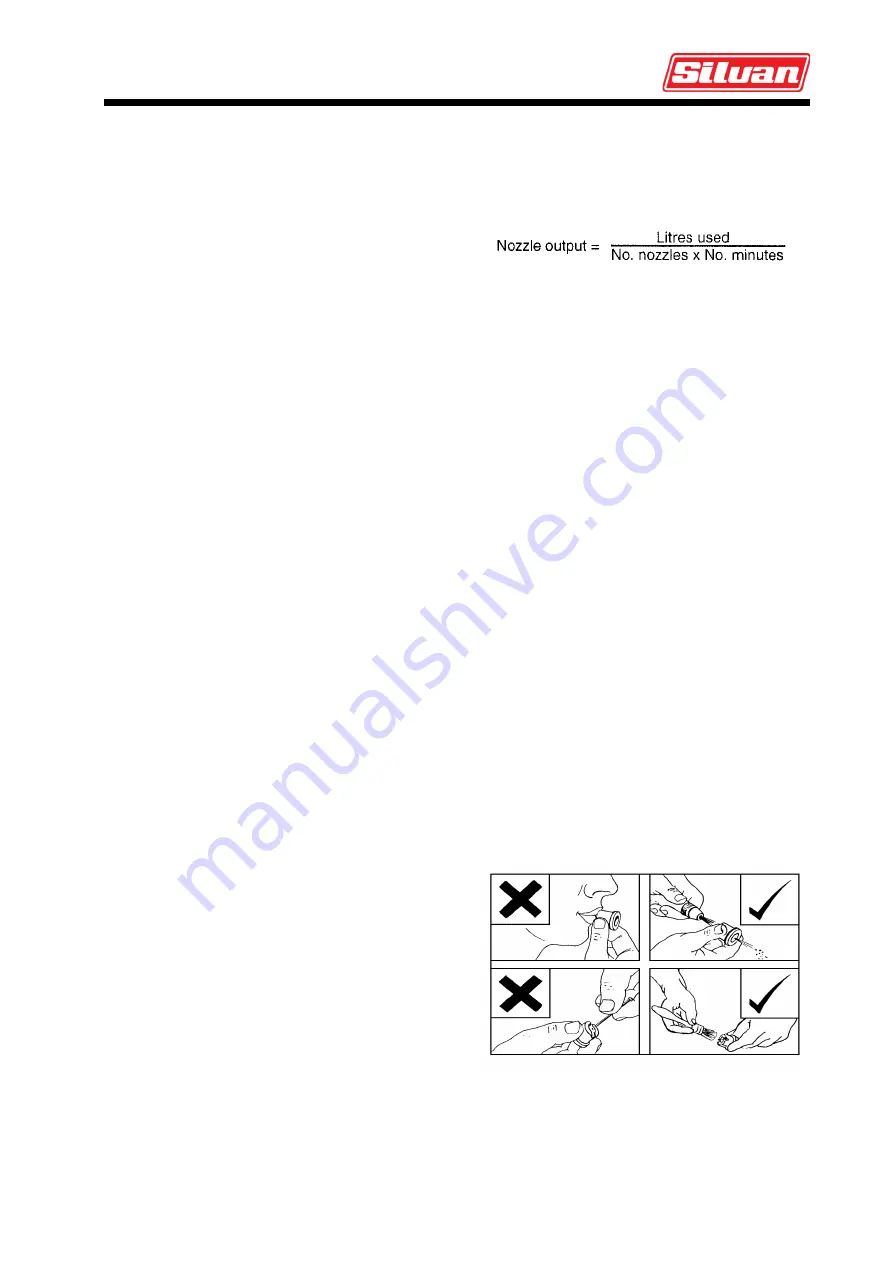
Calibration
15
Spray Pattern and Nozzle Uniformity
The overlap pattern of the boom, the spray
pattern of individual nozzles and the uniformity of
nozzle output can be tested in the following
manner. Always keep one new nozzle aside from
each set to use as comparator for this test.
1. Install the comparator nozzle, fill the sprayer
tank with clean water and operate the boom at
spraying pressure whilst stationary.
2. Examine the spray pattern from each nozzle
against a dark background. Replace any that
show streaks or signs of blockage.
3. Compare individual nozzle outputs by placing
a container of equal size, such as the Silvan
calibrated measuring jug, under each nozzle
and run the sprayer for one minute. The water
level in each container should be the same.
Replace any nozzle giving more than 10%
greater output than the comparator. Once
several nozzles are worn to this extent it is
good practice to replace the entire set.
4. Set the boom at the appropriate height for the
nozzle angle, i.e. 60 cm for 80
0
and 40 cm for
110
0
. Run the sprayer and check that the
patterns from adjacent nozzles just meet as
shown in the diagram on the previous page.
5. Remove and store the comparator nozzle.
Verifying the Calibration
After making the above tests to ensure pattern
and output uniformity are correct, repeat the
procedure at 3.0 Bar to compare the actual
nozzle output with that shown on the nozzle
selection charts. This may be done either as a
test on an individual nozzle or the full boom.
a) Nozzle Test
Measure the fluid in litres, collected from one
nozzle during one minute. The amount should
agree with the flow rate shown in the Nozzle
Selection Chart on the following pages, for the
particular type and size fitted.
If the volume collected is too low the operating
pressure may be increased and the test repeated,
alternatively if the volume is too high the pressure
can be lowered.
b) Boom Test
1. Partly fill the sprayer tank with water and mark
the level or refer to the sight gauge.
2. Run the sprayer at 3.0 Bar for several minutes
with all boom sections operating and measure
the time carefully.
3. Refill the sprayer tank to the mark using a
measuring jug and record the amount added.
4. The average output for one nozzle in l/min can
be calculated as follows. It should agree with
the flow rate shown at 3.0 Bar in the nozzle
selection chart, for the particular type and size
fitted.
5. If the nozzle output is lower than shown in the
chart the pressure may be increased and the
test repeated or, if more than shown, the
pressure may be reduced.
Nozzle Care and Maintenance
Nozzles are one of the most critical components
in the spraying system and yet are often the most
neglected. Worn or damaged nozzles result in
over application of expensive chemicals, crop
damage and environmental contamination.
They should be examined and checked regularly
by the method shown above. Replace nozzles
which are not within 10% of the datum.
Always keep a quantity of spare nozzles with the
sprayer for immediate replacement in the field
when necessary.
Never attempt to clear a nozzle by blowing
through by mouth and never remove stubborn
deposits with a pin, wire or sharp instrument.
Blocked nozzles should be soaked in clean, warm
water with a mild detergent added and carefully
cleaned only with a soft brush or airline.
A new nozzle should be kept as a testing
comparator and it is recommended that all
nozzles are renewed once a year or at the first
signs of deterioration, whichever occurs first.




















